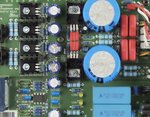mikaelmark
Junior Member level 2

By default design´s for power supply section in a pre amp, headphone amp or a DAC and when replacing standard rectifier diodes 1N400x with BYV27-200, I use to solder a 0,1 uF capacitor for each diode to eliminate unwanted high voltage peakes and noise.
But as I´ve been told by a technically know how-person that those bypass cap´s should only been used for standard rectifier diodes, eventually also combined with a low ohm resistor i serial. If this mod are being used with the better and faster BYV27, there may be a worser result as there will be a small amount of quiscent/leakage AC current.
But as some designs already is equipped with BYV27 combined with 0,1uF cap´s, do someone have any thoughts about this mod - is it only for standard rectifier diodes so BYV27´s whould be used without those cap´s of will it also do fine with BYV27´s?
Also, the same guy recommended to ground all speaker basket´s, to eliminate electrical static´s that will occur from the coil magnet and he told the positive effect from this mod will be heard. Has someone tried it and have any experience about it? Should it be worth doing?
But as I´ve been told by a technically know how-person that those bypass cap´s should only been used for standard rectifier diodes, eventually also combined with a low ohm resistor i serial. If this mod are being used with the better and faster BYV27, there may be a worser result as there will be a small amount of quiscent/leakage AC current.
But as some designs already is equipped with BYV27 combined with 0,1uF cap´s, do someone have any thoughts about this mod - is it only for standard rectifier diodes so BYV27´s whould be used without those cap´s of will it also do fine with BYV27´s?
Also, the same guy recommended to ground all speaker basket´s, to eliminate electrical static´s that will occur from the coil magnet and he told the positive effect from this mod will be heard. Has someone tried it and have any experience about it? Should it be worth doing?








